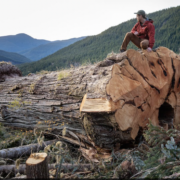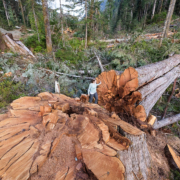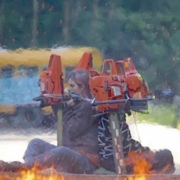Five ways BC’s new forestry plan sets the stage for more old-growth conflict
The Narhwal
June 2, 2021
In the midst of escalating protests over logging, Horgan released an intentions paper on Tuesday that critics say fails to implement any immediate solutions
As protests over old-growth logging continue to escalate on southern Vancouver Island, where more than 140 people have been arrested, all eyes were on the provincial government Tuesday as it announced much-anticipated action on the future of forest policy.
But the province’s policy intentions paper failed to present any immediate solutions to the problems unfolding on the landscape, deferring action on old-growth until 2023 in a move critics say sets the stage for more conflict.
“It’s just a stunning denial of the reality on the ground,” Torrance Coste, national campaign director with the Wilderness Committee, told The Narwhal in an interview. “There was a good chance that there were people arrested during the press conference.”
Ken Wu, executive director of the Endangered Ecosystems Alliance, also pointed out the stark contrast between the passion of hundreds of people fighting to protect ancient forests and “their connection to these magnificent living ecosystems” versus the government response.
“You have, essentially, these guys who are trying to buy time and take it slowly and not put in place the key components to actually save those ecosystems. You can see the fury developing.”
The intentions paper outlined how the province plans to implement changes to its forest management policies, including preparing the way to transfer forest tenures to First Nations, but according to numerous conservation organizations, the plan lacks key elements needed to support communities and protect biodiversity.
Here’s what you need to know about the province’s plan for BC forests.

1. No new BC old-growth logging deferrals implemented
In the spring of 2020, an independent panel commissioned by the province reviewed BC’s management of old forest ecosystems and called for a “paradigm shift” in the way the province oversees the forest industry. The panel made 14 recommendations, including an urgent need to immediately defer logging in old-growth forests at risk of irreversible biodiversity loss, to buy time for the province to develop a new strategy. The panel gave the province six months to implement deferrals.
At a press conference, Premier John Horgan claimed the province is working on implementing the recommendations and cited 200,000 hectares of deferrals that were implemented last year. But critics said those deferrals failed to protect ecosystems facing the highest risk, and noted deferrals are no more than temporary protective measures. https://thenarwhal.ca/bc-old-growth-forest-vancouver-island-caycuse/embed/#?secret=SPf1B04tkD
“To say they’re implementing the panel’s recommendations is demonstrably false,” Wu said. “They missed their six-month deadline — in fact, it’s been over a year and they haven’t implemented critical deferrals, in particular on the high-productivity old-growth.”
Last month, a trio of independent scientists analyzed and mapped the province’s old forests to provide the province with a ready-to-go tool for implementing the deferrals. As The Narwhal previously reported, the map identified about 1.3 million hectares of forest in harm’s way, which is around 2.6 per cent of BC’s timber supply.
The province’s plan did not include any new deferrals, instead noting it intends to commit to more deferrals.
A statement provided to The Narwhal by the Ministry of Forests, Lands, Natural Resource Operations and Rural Development said the panel did not recommend a pause on all old-growth harvesting and added one of the key recommendations is engaging the full involvement of Indigenous leaders and organizations.
“Indigenous engagement is critical but will take time,” the statement said. “Government recognizes the importance of this issue to many Indigenous nations, and has sought advice from some Indigenous organizations to develop an engagement approach that can be effective. Discussions have begun with some nations, but not all nations yet.”
During a press briefing, the province noted the organizations it consulted, including Indigenous organizations, were confidential.
In a recent interview with The Narwhal, Grand Chief Stewart Phillip, president of the Union of BC Indian Chiefs, said time is of the essence.
“It makes no sense to have a protracted dialogue if, at the end of it, we discover the old-growth is gone.”
“It’s a basic denial of what this moment requires,” Coste said of the province’s intentions paper. “This moment requires hitting the brakes, realizing that the public trust is extremely frail. And without that public trust, none of these intentions are achievable.”

2. No clear path for funding a transition to more sustainable BC forestry
According to critics, the intentions paper notably lacks a plan to financially support the province’s modernization goals, and warned that redistributing forest tenures from large logging companies to First Nations could perpetuate the harvest of at-risk ecosystems.
“The most insidious thing is that they look like they are working to increase the economic dependency of communities, including First Nations, through an economic stake in old-growth logging,” Wu said.
Coste said First Nations relying on the revenue generated by old-growth logging need to be compensated for any economic losses resulting from putting the brakes on forestry activities, but noted that Premier Horgan said he cannot implement deferrals without consent from Indigenous communities.
“The choice for First Nations is: agree to deferrals and get no revenue or agree to logging and get revenue. That’s not a choice, not after 150 years of colonization,” he said. “There’s zero dollars earmarked under that policy intention, zero dollars earmarked in the budget and zero plan for how these immediate, medium and long-term steps will be funded.”
Wu said without alternative economic solutions, old-growth logging will continue.
“That’s a game changer if there’s no funding and agreements to protect the at-risk old-growth and to finance the alternative, which is conservation-based economies,” he said. “[The province has] made no commitments to increase … provincial funding for Indigenous Protected and Conserved Areas and associated sustainable economic development.”
The Ministry of Forests did not respond to questions about allocating funding to support its policy intentions.
3. Province intends to double forest tenures held by First Nations
One of the principle themes outlined in the intentions paper is increasing Indigenous participation in BC’s forest management. At the press conference, Horgan repeated his government’s commitment to reconciliation.
“We continue to collaborate with First Nations, and others, to make sure that we protect species, and we protect the biodiversity that is so critically important to our old-growth forests,” he said. “It’s vital that we do not repeat the colonial activities of the past and [dictate to] the First Nations what they do on their territories today.”
According to Jessica Clogg, executive director and senior counsel with West Coast Environmental Law, these statements only addressed one side of the story.
“I was quite appalled at how the premier hid behind the Crown’s constitutional duties to Indigenous People in justifying [the province’s] failure to act on its commitment to immediately defer at-risk old-growth,” she said. “The province has continued for decades to issue cutting permits to new tenures, all without Indigenous consent, keeping the momentum of clearcut logging going in this province. And yet, when it comes to pressing the pause button in order to avoid talking and logging while negotiations are ongoing, the premier then trotted out consultations as an excuse.”
The plan, according to Horgan and Minister of Forests, Lands, Natural Resource Operations and Rural Development Katrine Conroy, is to double the tenures owned by First Nations.
“The idea of breaking up tenure concentration and ensuring local partnerships with Indigenous Peoples are all good words,” Clogg said. “But when you look at the details, you see the province saying that they hope to increase the amount of replaceable forest tenure held by Indigenous Peoples to 20 per cent from the current level of 10 per cent. That’s effectively saying that they intend to leave the other 80 per cent of logging rights in the control of major forest companies.”
She added that it’s more nuanced, but said the province’s commitment to implementing the Declaration of the Rights of Indigenous Peoples needs more than 20 per cent.
“That is barely scratching the surface.”
Clogg admitted one policy intention gives her some optimism.
“What I read as a commitment to work with Indigenous Peoples to reintroduce prescribed and ceremonial burning — there are definitely forest ecosystems in which Indigenous management through fire was an integral part of the historic ecosystem condition. That is a very positive thing.”
Wu noted the province has an opportunity to protect BC’s forests, which he said Horgan acknowledged.
“The one tiny little glimmer of hope is it seems like he’s recognized that the federal government is providing $2.3 billion largely for Indigenous Protected and Conserved Areas over the next five years and BC’s share of that would probably be [around] $300 million.”
He said that funding could be used to support communities as part of a strategy to save what’s left of BC’s old-growth.
4. Intentions include plans to maximize value and support local manufacturers
Several of the policy intentions focused on restructuring provincial rules and regulations to support local manufacturers, including addressing issues with the province’s own forestry outfit, BC Timber Sales, which manages about 20 per cent of BC’s forests.https://thenarwhal.ca/indicative-of-a-truly-corrupt-system-government-investigation-reveals-bc-timber-sales-violating-old-growth-logging-rules/embed/#?secret=yD5vFpAJW0
Clogg said there could be positive outcomes from revising how BC Timber Sales operates in the province, but warned any changes would need to be supported by additional measures to ensure local manufacturers don’t have to log themselves to access the wood.
The province also noted its intention to revise its rules on how companies operate on the landscape, which could reduce the amount of waste, which is typically burned on the forest floor. But Clogg said the wording in the intentions paper is vague.
“The way the language in the paper is structured, you could say the province is finally going to take some measures to prevent high-grading — taking some of the highest and best trees and leaving the rest,” she said. “On the flip side, we could be going back to the bad old days, where you had even more draconian ‘log it or lose it’ provisions.”
She added that the province’s plan does little to shift the forest industry away from being controlled by a handful of large companies.
“The underpinning foundation of our forest sector is a set of what we call tenures — various licences and logging rights — that were established between the ’40s and the ’60s, and were always designed to attract and support major logging companies,” she said. “That fundamental foundation would not be altered by these proposals.”
5. BC forestry plan does not address the biodiversity crisis
The 2020 old-growth strategic review urged the province to prioritize biodiversity and at-risk species over the economic benefits of the forest industry. The intentions paper does not mention biodiversity and instead focuses largely on forest-based economy.https://thenarwhal.ca/bc-biodiversity-targets-ecojustice-report/embed/#?secret=5voV5472Vv
Andrea Inness, campaigner with Ancient Forest Alliance, said in a statement that was a glaring omission from the intentions paper.
“A vision for BC’s forests that isn’t firmly rooted in ecological health does no favours for communities. This path continues to rob British Columbians of old-growth forests and the critical ecological services they provide while driving communities ever closer to the looming economic cliff ahead of them.”
Clogg said it was clear the province continues to view BC forests as timber supply, not ecosystems, and noted the speakers at the press conference included forest industry advocates and lacked any environmental organizations.
“The timber-oriented orientation of the intentions paper really leaves me doubting that this increased discretion the province now intends to give itself legally will be used in a way that protects biodiversity and ecosystem health or upholds Indigenous Rights.”
Read the original article








